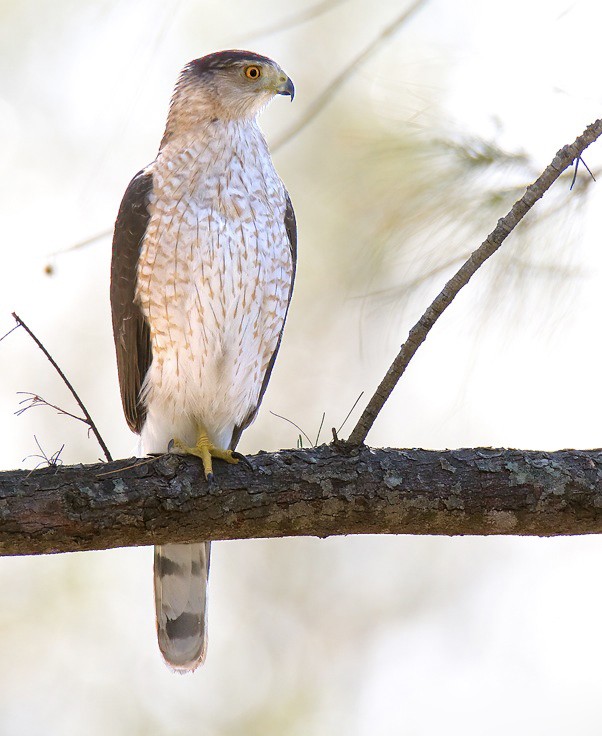Cooper's Hawk
A species of Bird Hawks, Also known as Stanley Hawk, Blue Dasher, Quail Hawk, Striker Scientific name : Accipiter cooperii Genus : Bird Hawks
Cooper's Hawk, A species of Bird Hawks
Also known as:
Stanley Hawk, Blue Dasher, Quail Hawk, Striker
Botanical name: Accipiter cooperii
Genus: Bird Hawks
 Photo By William H. Majoros , used under CC-BY-SA-3.0 /Cropped and compressed from original
Photo By William H. Majoros , used under CC-BY-SA-3.0 /Cropped and compressed from original Description
The cooper's Hawk is a medium-sized woodland raptor. This powerful hunter attacks small birds and mammals, and often drowns its prey in nearby water. As with many birds of prey, the male is significantly smaller than the female. Each year, the male chooses a new nesting site, and the female lays eggs on the exact same day each year. The bird's age can be told via the color of its eyes; they change color several times over its lifetime.
Size
36 - 53 cm
Life Expectancy
12 years
Nest Placement
Tree
Clutch Size
2 - 6 eggs
Incubation Period
1 brood
Number of Broods
30 - 36 days
Nestling Period
27 - 34 days
Feeding Habits
Cooper's Hawk predominantly preys on medium-sized birds such as starlings, doves, and pigeons, occasionally consuming smaller bird species and nestlings. In the western regions, their diet includes a higher proportion of mammals like chipmunks, hares, mice, squirrels, and bats.
Habitat
Cooper's Hawk is primarily found in a range of terrestrial habitats including deciduous and coniferous forests, woodlands, and riparian zones near rivers and streams. This species also adapts well to suburban settings with adequate tree coverage, often venturing into grasslands, fields, savannas, and chaparral. Cooper's Hawk prefers environments that provide a mix of open areas for hunting and dense foliage for nesting, typically at low to moderate altitudes. Cooper's Hawk's versatility allows it to thrive in temperate climates where it can find both ample prey and nesting sites.
Nest Behavior
Males construct the nest, with minimal help from females, over roughly two weeks. Nesting involves a cup around 8 inches across and 4 inches deep for the eggs, with attentive parental care following egg-laying.
Nest Characteristics
Cooper's Hawk's nests are built in a variety of trees, usually 25-50 feet above ground and often on flat terrain. The nest, a stick pile about 27 inches in diameter and 6-17 inches high, features a cup-shaped depression lined with bark flakes and occasionally green twigs.
Dite type
Avivorous
People often ask
Migration Overview
Like a majority of diurnal birds of prey in the Northern Hemisphere, the Cooper's hawk is a partial migrant. They tend to be most migratory in the north and largely to partially sedentary elsewhere. With individual exceptions, hawks of the species largely migrate out of nearly all of their range in southern Canada as well as cooler parts of the Pacific Northwest, essentially all of Montana and northern parts of surrounding states, the Dakotas (but for southern South Dakota), the northern parts of the Great Lake states, northern New York and much of New England. 
General Info
Feeding Habits
Bird food type
Bird Feeder Type

Platform
Sounds
Call
Recording location: Mexico
Call
Recording location: Mexico
Behavior
Cooper's Hawk display a distinctive flight pattern characterized by several strong wingbeats followed by gliding, which, during predation, turns into a swift and agile chase enabling them to navigate through dense foliage. Their daily activities involve skillful hunting and environmental interaction, highlighting their adaptation to woodlands and urban settings alike. In their mating rituals, cooper's Hawk engage in aerial shows of slow beats and gliding with wings in a V-shape, with males performing a bowing display to their mates, signifying the onset of nest construction.
Distribution Area
The Cooper's hawk’s breeding range extends from southern Canada to northern Mexico. Wintering Cooper's hawks are common through essentially all parts of Mexico, becoming less regular around Guatemala and isolated spots of the border of Honduras and Nicaragua, where the species is considered “infrequent but regular” as well as in central and southern Costa Rica and perhaps northern Panama. Vagrants have been recorded in Colombia. 
Species Status
Generally, Cooper's hawks hunt the locally common birds that are available and probably control some birds (such as the more numerous icterids and corvids) that may without the influence of natural predation risk overpopulation and potential harm to ecosystems. However, as an opportunistic natural predator of almost any North American bird smaller than itself, the Cooper's hawk may inadvertently deplete populations of rarer, conservation-dependent species. 